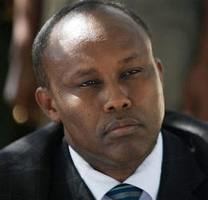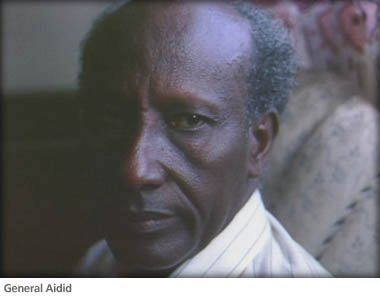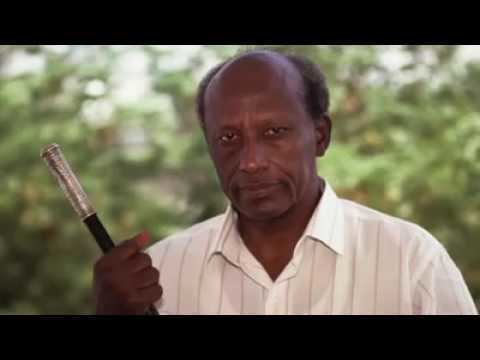Spouse(s) Khadiga Gurhan Children Hussein Farrah Aidid Role Military Commander | Name Mohamed Aidid Religion Islam | |
Alma mater Military academies in Russia Similar People Hussein Farrah Aidid, William F Garrison, Siad Barre, Abdullahi Yusuf Ahmed, Mohammed Said Hersi Morgan | ||
Mohamed farrah aidid
Mohamed Farrah Hassan Aidid (Somali: Maxamed Faarax Xasan Caydiid, Arabic: محمد فرح حسن عيديد; December 15, 1934 – August 1, 1996) was a Somali military commander and political leader. A former general and diplomat, he was the chairman of the United Somali Congress (USC) and later led the Somali National Alliance (SNA). Along with other armed opposition groups, they drove out President Mohamed Siad Barre's socialist regime from Somalia's capital Mogadishu during the Somali Civil War that broke out in the early 1990s.
Contents
- Mohamed farrah aidid
- Somalia Clan stages rally in support of leader
- Early years
- United Somali Congress
- Presidency declaration
- Death
- Family
- References

In 1992, Aidid attacked United Nations troops in the nation. He was one of the main targets of the Unified Task Force. After eventually forcing UN forces to withdraw in 1995, Aidid declared himself President of Somalia until he was killed the following year.

Somalia - Clan stages rally in support of leader
Early years

Aidid was born in 1934 in Beledweyne, Italian Somaliland to a Habar Gidir family. He was educated in Rome and Moscow and served in the Italian colonial police force in the 1950s. He later joined the Somali National Army.

For advanced military training, Aidid studied at the Frunze Military Academy (Военная академия им. М. В. Фрунзе) in the Soviet Union, an elite institution reserved for the most qualified officers of the Warsaw Pact armies and their allies.
In 1969, a few days after the assassination of Somalia's second president Abdirashid Ali Sharmarke, a military junta led by Major General Mohamed Siad Barre staged a bloodless coup d'état. Aidid was one of many officers serving at the central command of the Army at the time of the putsch. He quickly fell out of favour with the new regime's leaders and was subsequently detained. Aidid was eventually released from prison six years afterwards to take part in the 1977–78 war against Ethiopia over the disputed Ogaden region.
He later served as an advisor to President Barre and as Somalia's ambassador to India, before finally being appointed intelligence chief.
United Somali Congress
After fallout from the unsuccessful Ogaden campaign of the late 1970s, the Barre administration began arresting government and military officials under suspicion of participation in the abortive 1978 coup d'état. Most of the people who had allegedly helped plot the putsch were summarily executed. However, several officials managed to escape abroad and started to form the first of various dissident groups dedicated to ousting Barre's regime by force.
By the late 1980s, Barre's regime had become increasingly unpopular. The State took an increasingly hard line, and insurgencies, encouraged by Ethiopia's communist Derg administration, sprang up across the country. This eventually led in 1991 to the outbreak of the civil war, the toppling of Barre's government, and the disbandment of the Somali National Army (SNA). Many of the opposition groups subsequently began competing for influence in the power vacuum that followed the ouster of Barre's regime. Armed factions led by United Somali Congress (USC) commanders General Aidid and Ali Mahdi Mohamed, in particular, clashed as each sought to exert power over the capital. However, Aidid failed to attract many Somali leaders and intellectuals to the USC's cause, including fellow Frunze graduate General Abdullahi Ahmed Irro, who opted instead to remain politically neutral.
UN Security Council Resolution 733 and UN Security Council Resolution 746 led to the creation of UNOSOM I, the first stabilization mission in Somalia after the dissolution of the central government. United Nations Security Council Resolution 794 was unanimously passed on December 3, 1992, which approved a coalition of United Nations peacekeepers led by the United States. Forming the Unified Task Force (UNITAF), the alliance was tasked with assuring security until humanitarian efforts were transferred to the UN. Landing in 1993, the UN peacekeeping coalition started the two-year United Nations Operation in Somalia II (UNOSOM II) primarily in the south.
Presidency declaration
Aidid subsequently declared himself President of Somalia in June 1995. However, his declaration received no international recognition, as his rival Ali Mahdi Muhammad had already been elected interim president at a conference in Djibouti and recognized as such by the international community.
Consequently, Aidid's faction continued its quest for hegemony in the south. In September 1995, militia forces loyal to him attacked the city of Baidoa, killing 10 local residents and capturing at least 20 foreign aid workers.
Death
On July 24, 1996, Aidid and his men clashed with the forces of former allies Ali Mahdi Muhammad and Osman Ali Atto. Atto was a former supporter and financier of Aidid, and of the same subclan. Atto is alleged to have masterminded the defeat of Aidid. Aidid suffered a gunshot wound in the ensuing battle. He later died from a heart attack on August 2, either during or after surgery to treat his injuries.
Other officers allegedly targeted by Atto include General Talan. In its 2000 Country Report for Somalia, the U.S. Department of State asserted that the killing of Yusuf Tallan, a former general under the Barre regime, was connected to Osman Ali Atto "because of Atto's business deals in the north and the possibility of a deal between Somaliland President Egal and Atto in order to destablize the south."
Family
During the events leading up to the civil war, Aidid's wife Khadiga Gurhan sought asylum in Canada in 1989, moving the couple's four children with her. Local media shortly afterwards alleged that she had returned to Somalia for a five-month stay while still receiving welfare payments. Gurhan admitted in an interview to collecting welfare and having briefly traveled to Somalia in late 1991. However, it was later brought to light that she had been granted landed immigrant status in June 1991, thereby making her a legal resident of Canada. Additionally, Aidid's rival President Barre had been overthrown in January of that year. This altogether ensured that Gurhan's five-month trip would not have undermined her initial 1989 claim of refugee status. An official probe by Canadian immigration officials into the allegations also concluded that she had obtained her landing papers through normal legal processes.
Hussein Mohamed Farrah, son of General Aidid, emigrated to the United States when he was 17 years old. Staying 16 years in the country, he eventually became a naturalized citizen and later a United States Marine who served in Somalia. Two days after his father's death, the Somali National Alliance declared Farrah as the new President, although he too was not internationally recognized as such.
